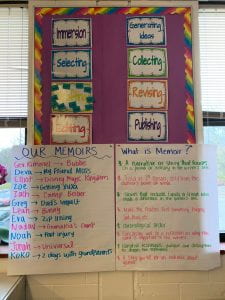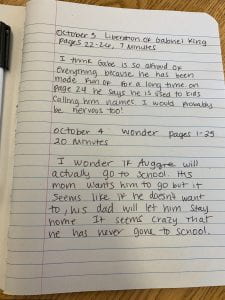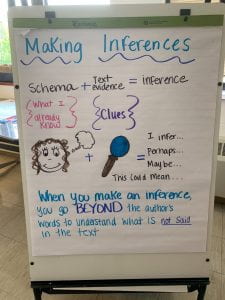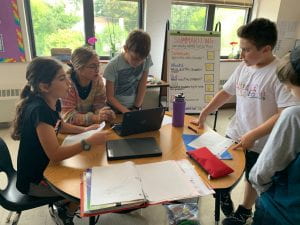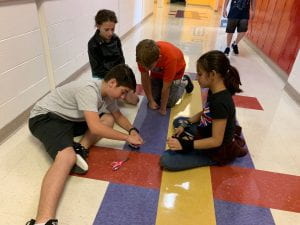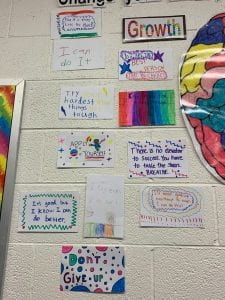Last week Friday was our last ETC class of first quarter. As you know, we spent the entire quarter completing mini challenges to develop multiple skills around teamwork. We explained to the class that even though we thought that the overall experience of the quarter was incredible, there are definitely some changes we will make before we repeat this cycle. In addition, what really mattered was how they felt about the experience. With that being said, we asked your kids for some feedback. We want to share a few of their responses:
Category Archives: ELA Updates
Drafting our Memoirs
Memoir rough drafts are in full swing! We spent the last month or so learning all about the characteristics of memoir and writing tons in our binders. The short writing pieces helped us generate ideas and get comfortable writing in 5th grade. Today we selected our large theme and throughout the week we will draft three different narratives that will make up our complete memoirs. I can’t wait for the kids to share their published pieces with you! Stay tuned!
The Connection Between Reading and Writing – 5th ELA
Today our reading and writing worlds collided. In reading, we’ve been studying point of view and how the perspective can really impact the story. In writing, we’ve been immersing ourselves in mentor texts to learn about the characteristics of a memoir.
Our focus today was having the expert point of view in memoir writing. Authors of memoirs are able to share memories with such vivid detail and description because they lived the memory. From any other point of view, the memory would look, feel and sound different.
After sharing our mentor text, and a writing sample, students were asked to look at their list of memories they’ve been keeping in their binders, choose one, and write. Afterward, we shared. I am continually impressed by your children as they have no fear in sharing very drafty pieces of writing with their peers. How amazing to see such strong confidence so early in the school year. It shows the trust they have in themselves and each other.
The pieces/lists/ideas they wrote today may end up being their published pieces, or they may choose another memory to focus on. Stay tuned! 🙂
Point of View
![]() Happy Thursday! I am so glad to be back at school learning with your children!
Happy Thursday! I am so glad to be back at school learning with your children!
As we continued our study of fiction today, we thought about how the point of view of the narrator makes a huge impact on the story. Would the Harry Potter series be the same if told from the perspective of Voldemort? How about Cinderella told through the view of the Prince? Point of view is crucial to a story!
We talked about how the best readers will often imagine how characters outside of the narrator may tell the story differently. Or, if a story is told in third person, what the characters are thinking outside of their dialogue and actions.
After the lesson, the kids thought about their independent reading books and the point of view of the narrators in their texts. They wrote reading responses to show their understanding.
Please ask your children about the lesson from their point of view…pun intended!
PS. I think we can all agree that I am not the best symmetrical artist- but the kids enjoyed my anchor chart regardless!
Reading Response Homework
Today I introduced our thinking Journals to use at home for reading responses. Most weeks I will assign 3 reading responses to be due the following week. This means that your child should be reading for at least 20 minutes, three times a week at home. In addition, they should be using their thinking journals to respond to what they have read.
We talked about the expectations for responses, put rubrics in our journals and looked at a few examples together. As we delve further into our fiction unit we will practice the different strategies to use when responding to a text.
 Loading...
Loading...
At this point in fifth grade, I expect students to respond by using at least one of our strategies. Next quarter I will expect them to use two and as each quarter progresses, the expectation will grow. This will allow them the time to practice the different strategies before 6th grade where they will be expected to use multiple strategies throughout the entire year.
When reading responses are assigned they will be written in assignment notebooks daily! 🙂 They have TWO responses due on Monday.

Word Work Wednesday 5th ELA
It’s Word Work Wednesday! Each week we will dedicate our Wednesday class session to developing our spelling, grammar and understanding of the English Language.
Today’s focus was on capitalization. Over the years, your children learned many different rules related to capitalization. As early as kindergarten, they learned that their name must begin with a capital letter, and so must the word “I” and the first word of a sentence. These are the “basics.” As they continued through elementary school, other rules were added to the mix, and they did their best to remember and use them. In today’s lesson, we reviewed the rules for capital letters and made a promise to one another to always try to apply those rules in any piece of writing we produce. We looked at a sample of writing that used correct capitalization, rather than incorrect, and noticed how often capital letters are used in writing.
I shared with the class that there are so many rules, that even as an adult, and ELA teacher, I often have to look up the rules while I’m writing! For this reason, I’ve given them a cheat sheet to keep in their ELA binders to reference while writing.
Making Inferences about Characters 5th ELA
When you make an inference, you go BEYOND the author’s words to understand what is not said in the text.
I’ve taught ELA for 13 years (crazy!) and over and over again I see that our kiddos struggle with going beyond the literal meaning of the text. In my opinion, It is actually the best and most fun part about reading- what does the author want us to think and/or feel without directly saying it? It’s like solving a puzzle. To master this skill, you have to first understand how to make an inference!
Using our amazing mentor text, The Liberation of Gabriel King, we focused on making inferences today. We specifically focused on making inferences connected to character traits. We talked about connecting our schema (our background knowledge/ mental filing cabinets) to text evidence to form inferences. Our discussion included the need to directly quote from the text to really support our thinking.
Afterward, the kids practiced this skill in their own books. We ended class by sharing out our ideas and thoughts. The kiddos did a great job and will continue developing these skills throughout this unit and beyond.
I can… 5th ELA Learning Targets
Reading Workshop is in full swing! Our first reading unit is focused on fiction. We have started mini lessons and practicing new skills in our reading binders. Reading homework in the thinking journal will be assigned later this week.
Each mini lesson will be connected to one of our ten priority standards for this unit. Each student will work on these ten standards throughout the course of the quarter, monitoring their progress toward mastery – of course at their own pace and using differentiated text.
I’m excited to watch their growth this quarter!
Make it Move Challenge- ETC
On Wednesday, we dove into our first team challenge of the year. The Make it Move Challenge— can you move a matchbox car across a table without using your body to propel it and without lifting the table? How will you do it using only the materials provided?
(We encourage you to look at the presentation we used in class {linked above} as it will give you an insight into the process we take the kids through.)
The kids were asked to work in groups for the first time this year. We purposefully didn’t give many directions or go over teamwork expectations. Are we crazy? Maybe! But, it all worked out how we wanted it to!
The kids got started. As expected, a few groups had come up with quick solutions that ended up failing. They didn’t meet the requirements, or their plan didn’t work out. What did the kids do? They planned again! They tested again and again until they were successful, or ran out of time!
At the end of class, we reflected together. Many students expressed that there were a wide range of emotions felt in class- excitement to get started, frustration with themselves of others, annoyance with materials, and the one we heard over and over- aggravation for not getting more direction.
This led us to the most perfect conversation. Our intent. EtC is a low stakes class, with unlimited potential, where students will be able to develop teamwork skills, showcase creativity and innovation, and most importantly, fail over and over again. We explained that if we had given TOO many directions or parameters, it would have limited their thinking and willingness to experiment. Instead, we had 5 groups all trying out different plans. We had groups communicating beautifully and other teams struggling to share responsibility. It was sensational. And, it was the perfect segue, as next week we will start examining our teamwork rubric and practicing teamwork expectations in class. We can’t wait!
Check out the pictures and videos below that show the different stages of the challenge!
Gev. Kimmel, Gev. McAdams & Gev. Noorlander
Individual Planning
Team Sharing/Planning
Creating/Executing Plans
Testing
Neuroplasticity and a Growth Mindset in 5th Grade
Did you know your brain is like a muscle? This week we learned a new word: neuroplasticity– the ability of the brain to form and reorganize synaptic connections, especially in response to learning or experience or following injury. In other words, your brain is capable of anything and grows through challenge, failure and struggle. The harder we work it, the stronger it will get.
Why does this matter in 5th grade? This year I will do my absolute best to challenge your kids every single day. I will encourage them to take risks, fail, and be vulnerable as they try new things. This is going to be really hard for your kiddos. They will feel frustrated, and maybe even want to give up. If this happens, I’ve accomplished my goal. Not because I’m an evil teacher who wants to make your kids cry, but because I want to prepare your child to embrace failure and hardship with a growth mindset and willingness to persevere through the tough stuff. And don’t worry, I’ll be there if the tears start flowing!
We spent the week digging deeper into what it means to have a growth mindset. We watched videos, discussed the importance of failure and perseverance and thought about what to do and/or say when we are feeling fixed in 5th grade. Each child came up with a personal mantra that we hung up as a constant reminder to “stick with it,” even when times are tough. Please ask your child which mantra they chose and why!
Shabbat Shalom!
Gev. Kimmel

